GENERATION, TRANSMISSION & DISTRIBUTION


When people talk about the electric power industry, the focus is usually on the power generation side or on the utilities. The power generation side examines the extraction of electricity from fossil fuels and or electric energy generation from alternate sources including nuclear power. The utilities side focuses on the customer-oriented delivery side of the business, from electricity bill surcharges to outages and or quality in our electricity supply.
A third and often overlooked portion of the power and energy industry is the transmission and distribution space (T&D;), an important cluster of industries that include the production of machinery, electric lines and transformers as well as line management systems such as "smart-grid" technology that improve efficiency. These are responsible for the actual “delivery” of the electric power—no matter the generation source, be it coal, nuclear, solar, gas, oil, wind or otherwise—to commercial, private and industrial users in a usable manner. Kindly refer to the picture below to understand this better.
GENERATION : AC Electric Power Generation is done by Alternators which are run using fossil fuels like Coal, Petroleum, Natural Gas etc. Hydro-electric Power, Nuclear fission, Solar, Wind, Wave and Geo Thermal energy sources are also utilized for Power generation.
TRANSMISSION : AC electric power’s voltage can be increased and decreased easily using transformers and unlike DC electric power, AC electric power can be transmitted in high voltages across long distances without much loss. The places of usage of electric power is spread all around and as generation of power is done only at specific places, it has to be transmitted over long distances. AC electric power is increased to High Voltages ( 22 / 110 / 440 kilo Volts ) and transmitted over long distances, without much losses.
DISTRIBUTION: After being transmitted at very high voltages, AC power is brought down to normal usable voltage levels ( 440 Volts in 3 phase or 220 / 110 Volts in Single phase ). It is then distributed to our homes, factories, shops, offices etc. The main components in distribution of power are Sub stations, Feeder Lines, Distribution Transformers, Switches, Junction Boxes, Primary & Secondary lines etc. Generally this supply of Electricity or the Distribution mechanism is handled by Electrical Utility Systems.
TYPES OF CONSUMERS OF POWER : Major usage groups of electric power are Agriculture ( irrigation pumps ), Industry, Commercial ( offices, banks & shops etc ), Residential ( Homes ), Transport ( railways ) and Public Systems ( Street Light etc ).

Copyright © 2017 VsolV, Rights Reserved. Designed by HourGlassIT | Web Design Services Chennai